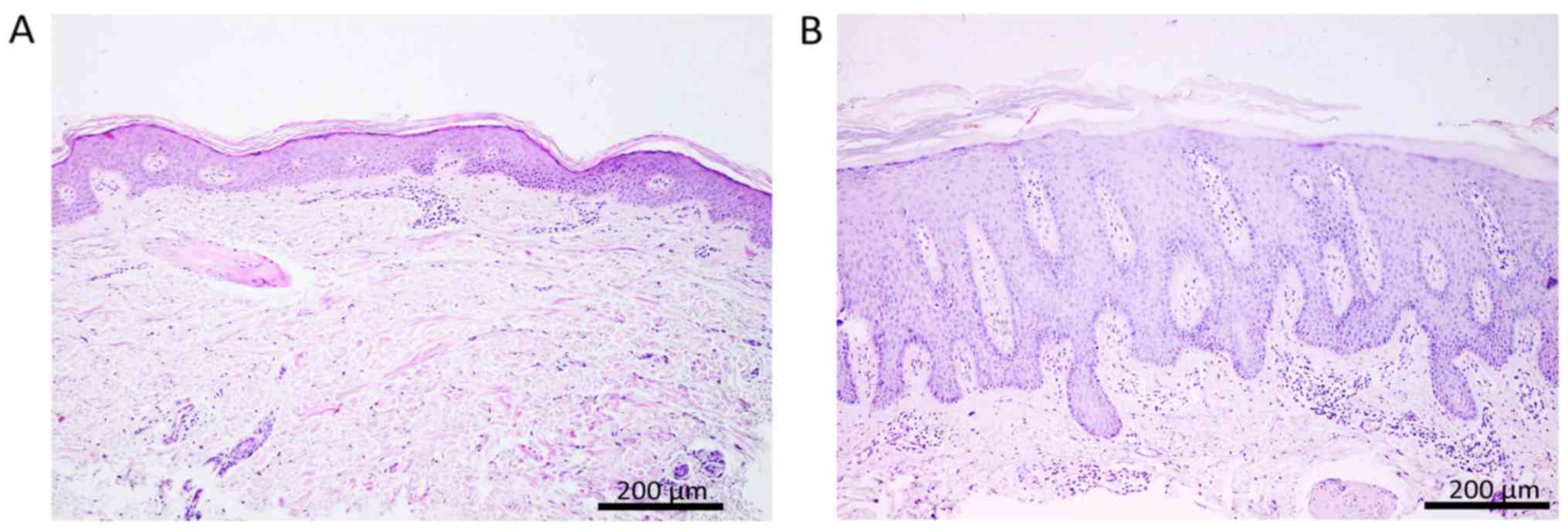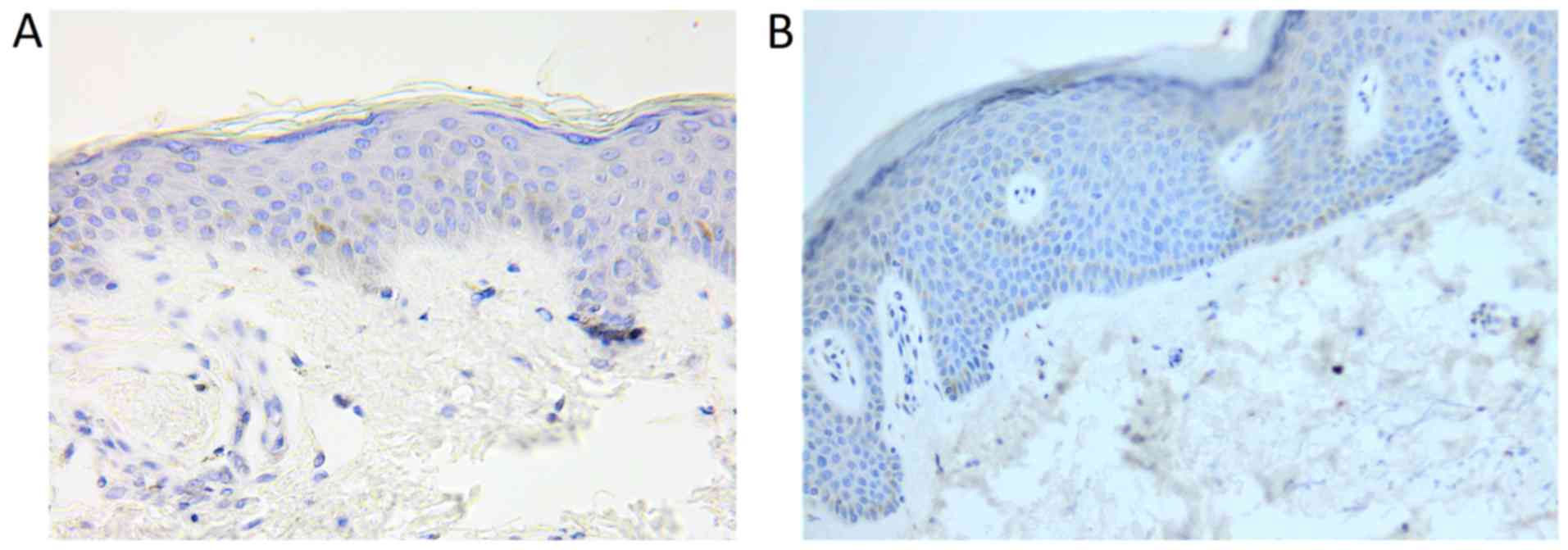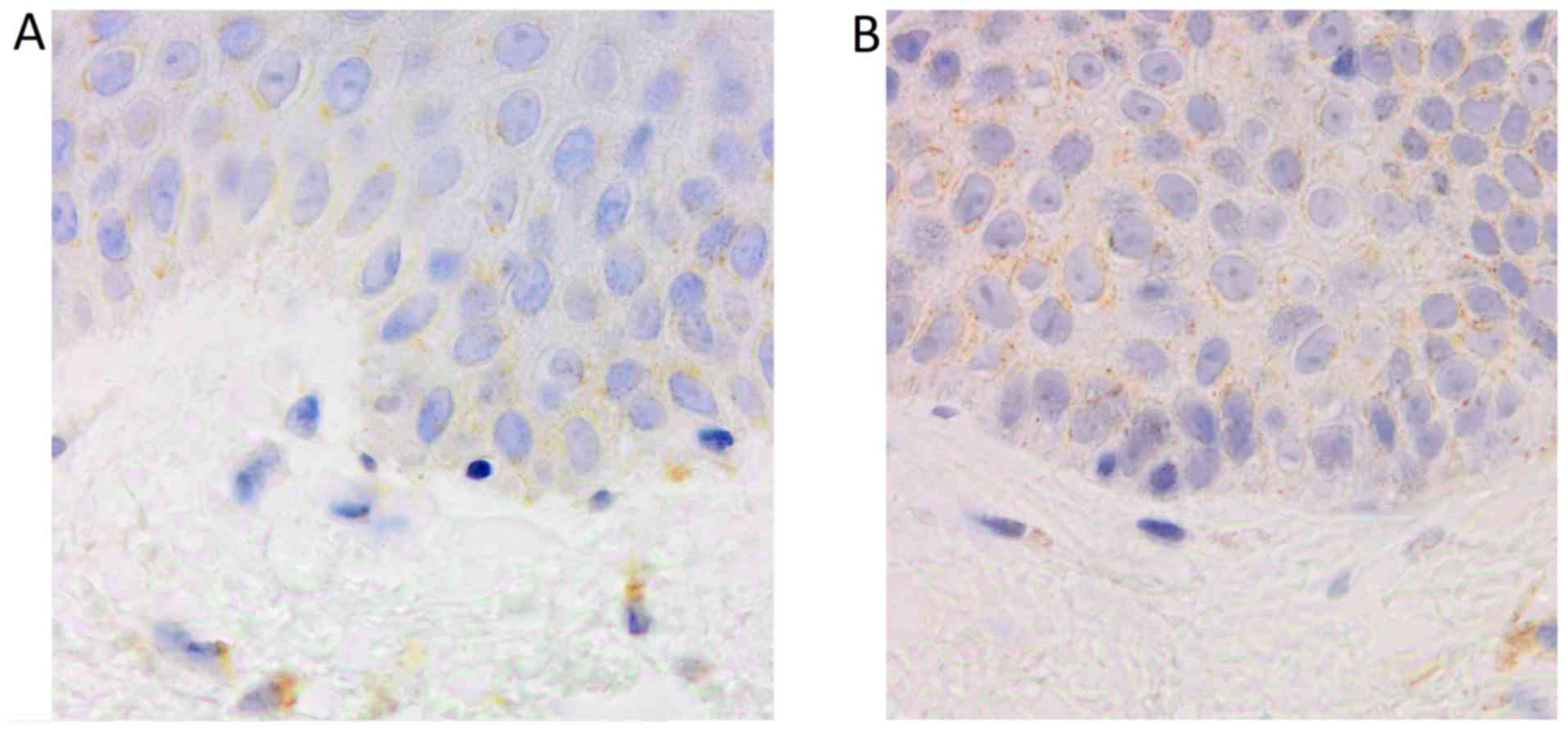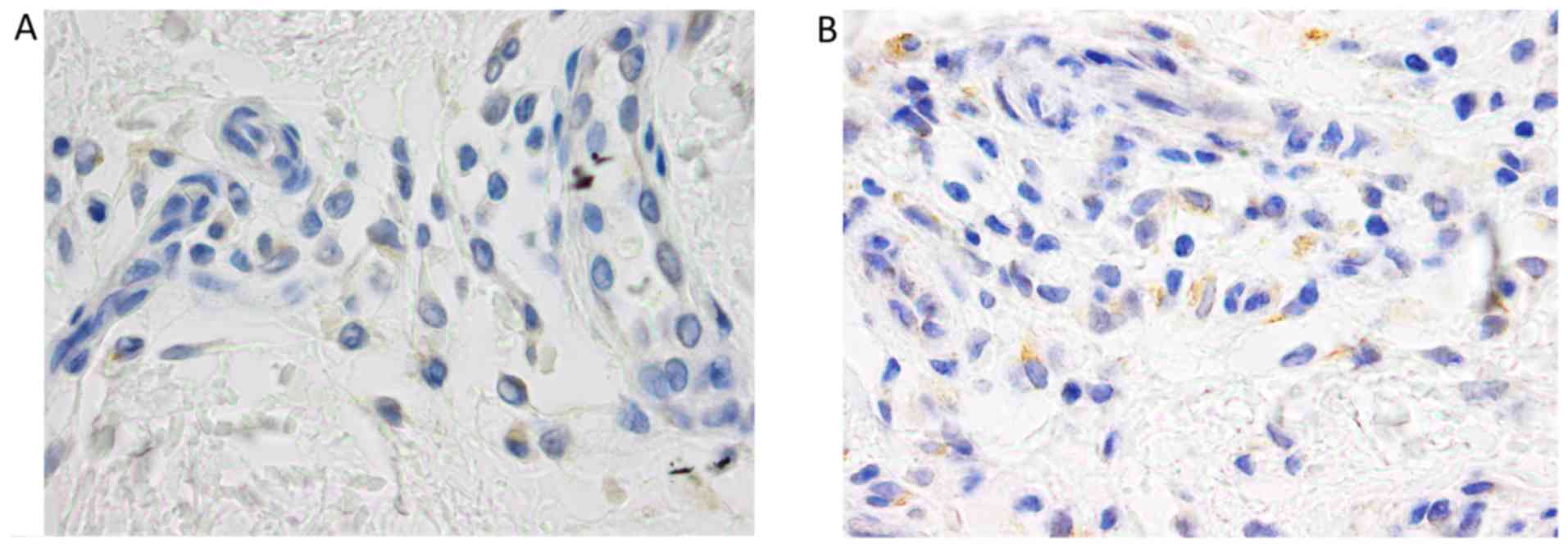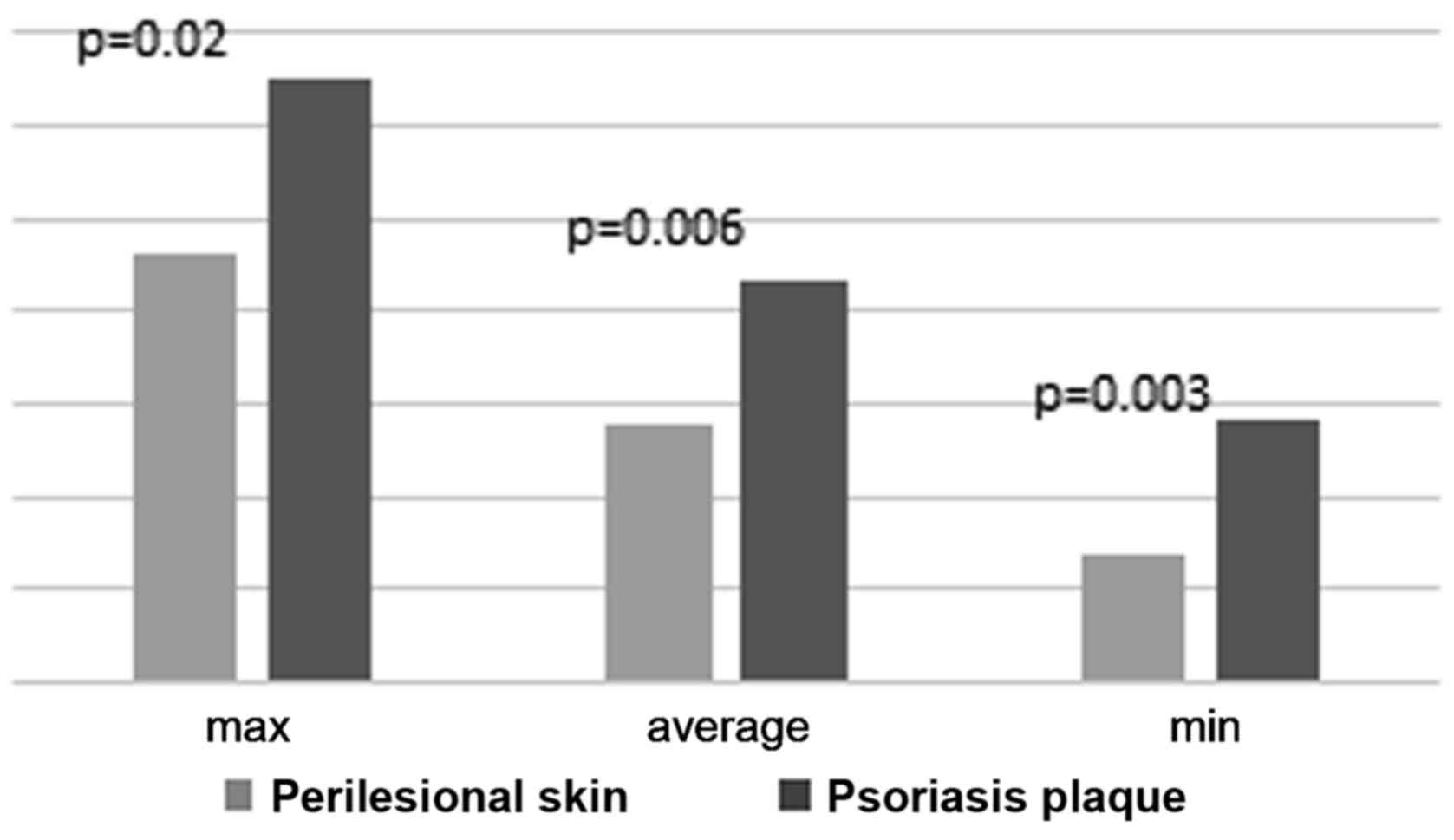|
1
|
Parisi R, Symmons DP, Griffiths CE and
Ashcroft DM; Identification, Management of Psoriasis and Associated
ComorbidiTy (IMPACT) project team, : Global epidemiology of
psoriasis: A systematic review of incidence and prevalence. J
Invest Dermatol. 133:377–385. 2013. View Article : Google Scholar : PubMed/NCBI
|
|
2
|
Batani A, Brănișteanu DE, Ilie MA, Boda D,
Ianosi S, Ianosi G and Caruntu C: Assessment of dermal papillary
and microvascular parameters in psoriasis vulgaris using in vivo
reflectance confocal microscopy. Exp Ther Med. 15:1241–1246.
2018.PubMed/NCBI
|
|
3
|
Deng Y, Chang C and Lu Q: The inflammatory
response in psoriasis: A comprehensive review. Clin Rev Allergy
Immunol. 50:377–389. 2016. View Article : Google Scholar : PubMed/NCBI
|
|
4
|
Boda D, Negrei C, Nicolescu F and Balalau
C: Assessment of some oxidative stress parameters in methotrexate
treated psoriasis patients. Farmacia. 62:704–710. 2014.
|
|
5
|
Raţiu MP, Purcărea I, Popa F, Purcărea VL,
Purcărea TV, Lupuleasa D and Boda D: Escaping the economic turn
down through performing employees, creative leaders and growth
driver capabilities in the Romanian pharmaceutical industry.
Farmacia. 59:119–130. 2011.
|
|
6
|
Negrei C, Caruntu C, Ginghina O, Burcea
Dragomiroiu GT, Toderescu CD and Boda D: Qualitative and
quantitative determination of methotrexate polyglutamates in
erythrocytes by high performance liquid chromatography. Rev Chim.
66:607–610. 2015.
|
|
7
|
Negrei C, Ginghină O, Căruntu C, Burcea
Dragomiroiu GT, Jinescu G and Boda D: Investigation relevance of
methotrexate polyglutamates in biological systems by high
performance liquid chromatography. Rev Chim. 66:766–768. 2015.
|
|
8
|
Caruntu C, Boda D, Dumitrascu G,
Constantin C and Neagu M: Proteomics focusing on immune markers in
psoriatic arthritis. Biomarkers Med. 9:513–528. 2015. View Article : Google Scholar
|
|
9
|
Kanda N, Hau CS, Tada Y and Watanabe S:
Prolactin may promote the development of psoriasis: Reawakened
issue. J Clin Exp Dermatol Res. 4:10001982013.
|
|
10
|
Foitzik K, Langan EA and Paus R: Prolactin
and the skin: A dermatological perspective on an ancient
pleiotropic peptide hormone. J Invest Dermatol. 129:1071–1087.
2009. View Article : Google Scholar : PubMed/NCBI
|
|
11
|
Kanda N, Shibata S, Tada Y, Nashiro K,
Tamaki K and Watanabe S: Prolactin enhances basal and IL-17-induced
CCL20 production by human keratinocytes. Eur J Immunol.
39:996–1006. 2009. View Article : Google Scholar : PubMed/NCBI
|
|
12
|
Olteanu R, Constantin MM, Zota A,
Dorobantu D, Constantin T, Serban ED, Balanescu P, Mihele D and
Gheuca-Solovastru L: Original clinical experience and approach to
treatment study with interleukine 12/23 inhibitor in
moderate-to-severe psoriasis patients. Farmacia. 64:918–921.
2016.
|
|
13
|
Sunnemark D, Ulfgren AK, Örn A and Harris
RA: Cytokine production in hearts of Trypanosoma
cruzi-infected CBA mice: Do cytokine patterns in chronic stage
reflect the establishment of myocardial pathology? Scand J Immunol.
44:421–429. 1996. View Article : Google Scholar : PubMed/NCBI
|
|
14
|
Charles CA, Romanelli P, Martinez ZB, Ma
F, Roberts B and Kirsner RS: Tumor necrosis factor-alfa in
nonhealing venous leg ulcers. J Am Acad Dermatol. 60:951–955. 2009.
View Article : Google Scholar : PubMed/NCBI
|
|
15
|
Ettehadi P, Greaves MW, Wallach D, Aderka
D and Camp RD: Elevated tumour necrosis factor-α (TNF-α) biological
activity in psoriatic skin lesions. Clin Exp Immunol. 96:146–151.
1994. View Article : Google Scholar : PubMed/NCBI
|
|
16
|
Moorchung N, Vasudevan B, Mani NS and
Verma R: Expression of tumor necrosis factor-α and nuclear
factor-kappaB/RelA and the pathogenesis of psoriasis. Indian J
Pathol Microbiol. 57:205–208. 2014. View Article : Google Scholar : PubMed/NCBI
|
|
17
|
Johansen C, Funding AT, Otkjaer K,
Kragballe K, Jensen UB, Madsen M, Binderup L, Skak-Nielsen T,
Fjording MS and Iversen L: Protein expression of TNF-alpha in
psoriatic skin is regulated at a posttranscriptional level by
MAPK-activated protein kinase 2. J Immunol. 176:1431–1438. 2006.
View Article : Google Scholar : PubMed/NCBI
|
|
18
|
Sereflican B, Goksugur N, Bugdayci G,
Polat M and Haydar Parlak A: Serum visfatin, adiponectin, and tumor
necrosis factor alpha (TNF-α) levels in patients with psoriasis and
their correlation with disease severity. Acta Dermatovenerol Croat.
24:13–19. 2016.PubMed/NCBI
|
|
19
|
Olteanu R, Zota A and Constantin M:
Biosimilars: An update on clinical trials (review of published and
ongoing studies). Acta Dermatovenerol Croat. 25:57–66.
2017.PubMed/NCBI
|
|
20
|
Zhu JW, Wu XJ, Lu ZF, Luo D, Cai SQ and
Zheng M: Role of VEGF receptors in normal and psoriatic human
keratinocytes: Evidence from irradiation with different UV sources.
PLoS One. 8:e554632013. View Article : Google Scholar : PubMed/NCBI
|
|
21
|
Kristensen M, Chu CQ, Eedy DJ, Feldmann M,
Brennan FM and Breathnach SM: Localization of tumour necrosis
factor-alpha (TNF-alpha) and its receptors in normal and psoriatic
skin: Epidermal cells express the 55-kD but not the 75-kD TNF
receptor. Clin Exp Immunol. 94:354–362. 1993. View Article : Google Scholar : PubMed/NCBI
|
|
22
|
Sidhom E, Pilmane M and Kisis J: Local
antimicrobial, protease and cytokine defense systems in psoriatic
skin. Indian J Dermatol Venereol Leprol. 82:284–291. 2016.
View Article : Google Scholar : PubMed/NCBI
|
|
23
|
Theodorakopoulou E, Yiu ZZ, Bundy C,
Chularojanamontri L, Gittins M, Jamieson LA, Motta L, Warren RB and
Griffiths CE: Early- and late-onset psoriasis: A cross-sectional
clinical and immunocytochemical investigation. Br J Dermatol.
175:1038–1044. 2016. View Article : Google Scholar : PubMed/NCBI
|
|
24
|
Campanati A, Goteri G, Simonetti O,
Ganzetti G, Giuliodori K, Giuliano A, Sabato S, Stramazzotti D,
Gulini E, Dusi D, et al: Angiogenesis in psoriatic skin and its
modifications after administration of etanercept:
Videocapillaroscopic, histological and immunohistochemical
evaluation. Int J Immunopathol Pharmacol. 22:371–377. 2009.
View Article : Google Scholar : PubMed/NCBI
|
|
25
|
Negrei C, Arsene AL, Toderescu CD, Boda D
and Ilie M: Acitretin treatment in psoriazis may influence the cell
membrane fluidity. Farmacia. 60:767–771. 2012.
|
|
26
|
Simonetti O, Lucarini G, Goteri G, Zizzi
A, Biagini G, Lo Muzio L and Offidani A: VEGF is likely a key
factor in the link between inflammation and angiogenesis in
psoriasis: Results of an immunohistochemical study. Int J
Immunopathol Pharmacol. 19:751–760. 2006. View Article : Google Scholar : PubMed/NCBI
|
|
27
|
Flisiak I, Zaniewski P, Rogalska M,
Myśliwiec H, Jaroszewicz J and Chodynicka B: Effect of psoriasis
activity on VEGF and its soluble receptors concentrations in serum
and plaque scales. Cytokine. 52:225–229. 2010. View Article : Google Scholar : PubMed/NCBI
|
|
28
|
Keen MA and Hassan I: Serum prolactin
levels in psoriasis and its association with disease activity: A
case-control study. Indian J Dermatol. 59:562–566. 2014. View Article : Google Scholar : PubMed/NCBI
|
|
29
|
Kato AM, Gheida SF and El-Bendary AS:
Serum level of prolactin in psoriatic patients. EDOJ. 2:12012.
|
|
30
|
Dilmé-Carreras E, Martín-Ezquerra G,
Sánchez-Regaña M and Umbert-Millet P: Serum prolactin levels in
psoriasis and correlation with cutaneous disease activity. Clin Exp
Dermatol. 36:29–32. 2011. View Article : Google Scholar
|















